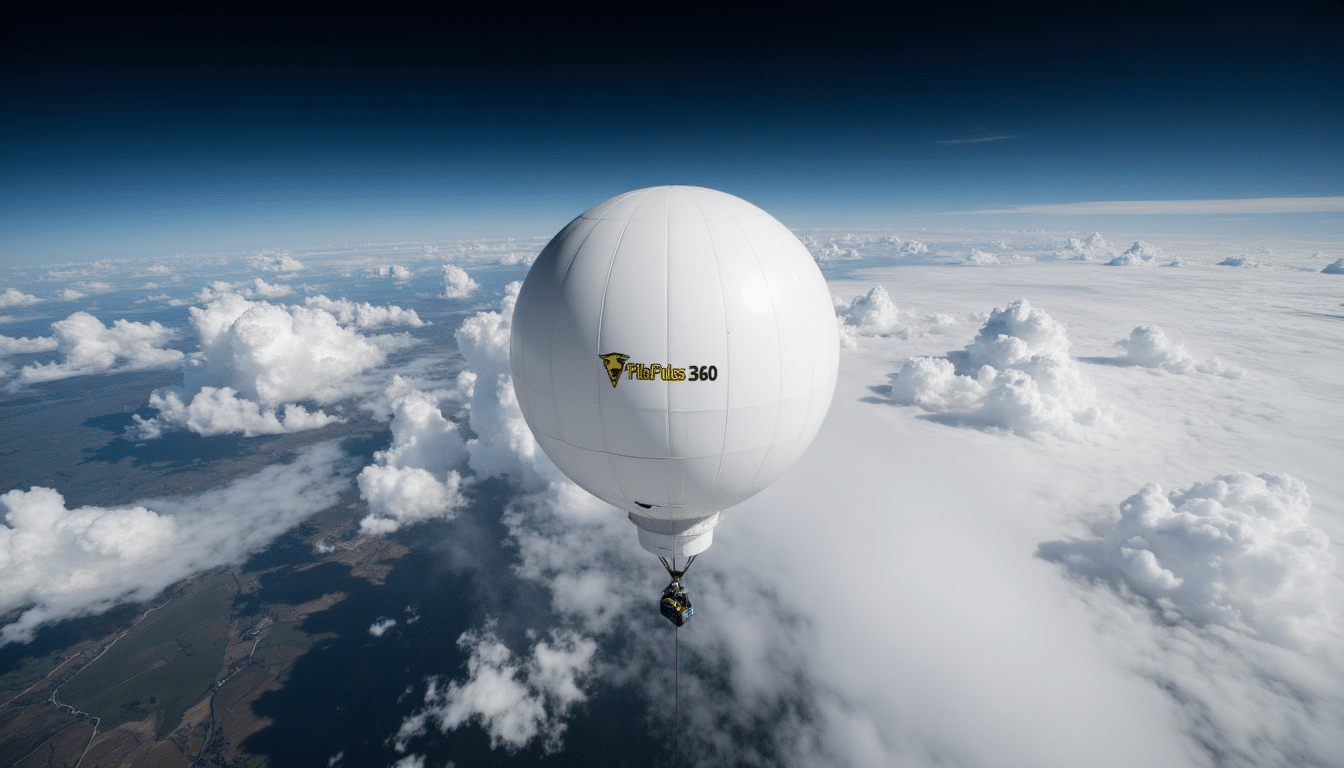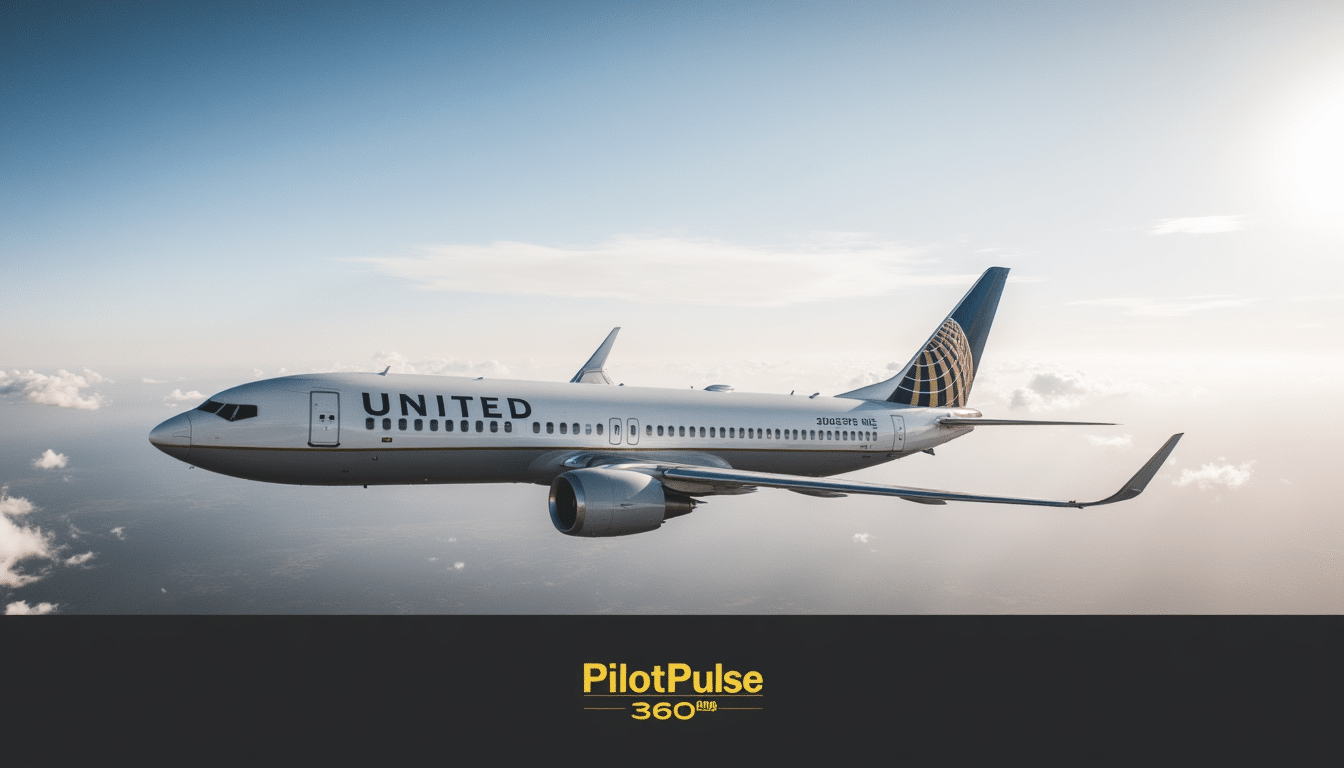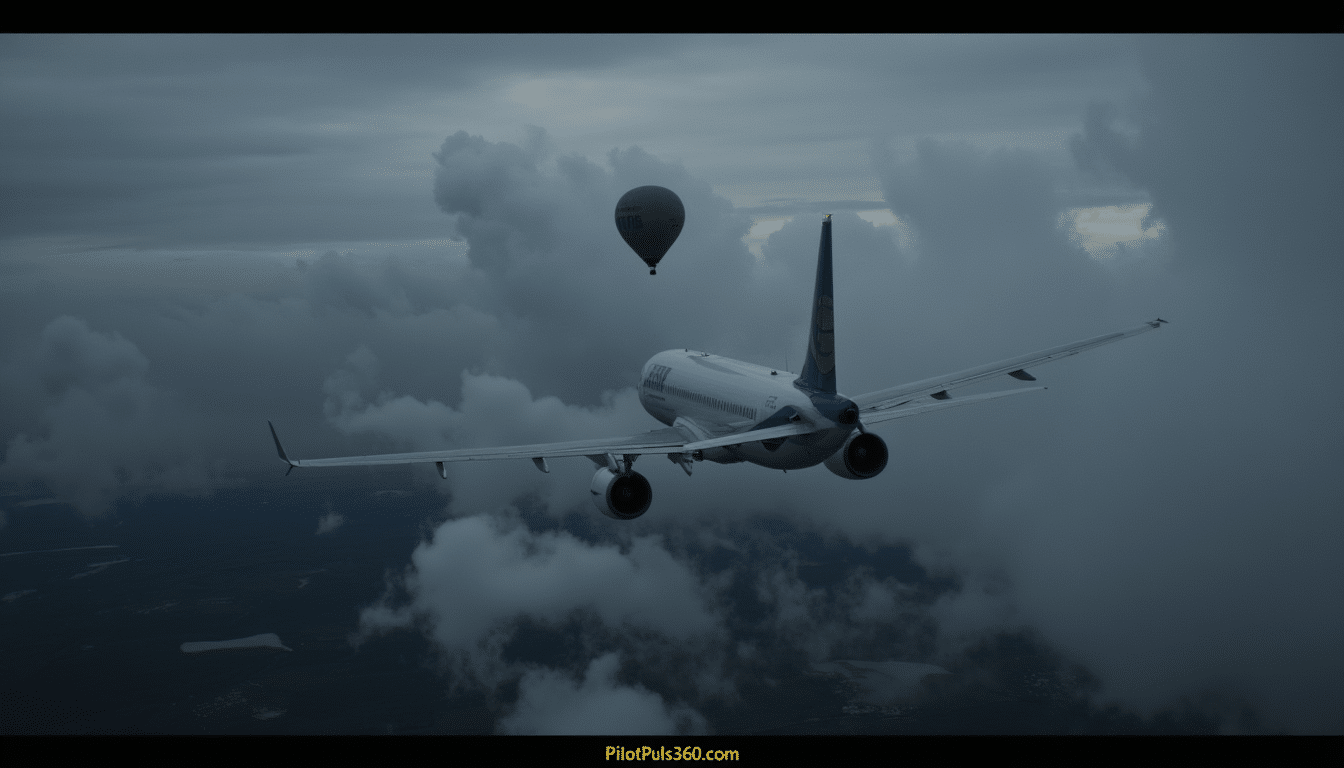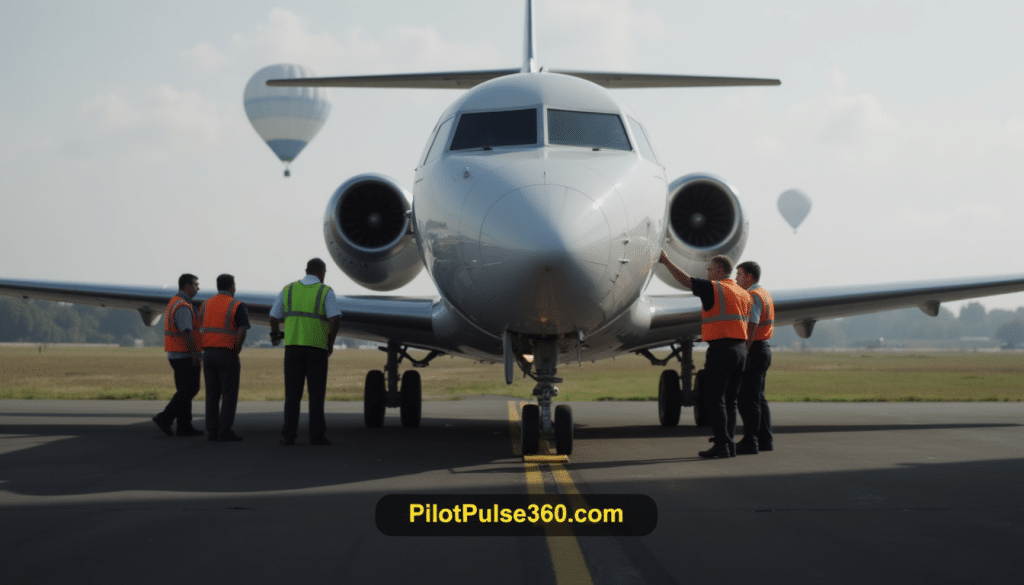Aviation News
Weather Balloon Company Believes Its Product Struck United Airlines Jet
WindBorne Systems says one of its weather balloons likely struck a United Airlines 737 MAX 8 flying at about 36,000 feet. The impact cracked the windshield and injured a pilot, forcing the crew to divert to Salt Lake City. The jet landed safely, and the company is now working with the FAA and NTSB to investigate. WindBorne has also begun reducing flight time between 30,000 and 40,000 feet and is designing new hardware to lower impact risks.
Incident Overview
On October 16, United Airlines flight UA1093 was en route from Denver to Los Angeles when the crew reported a cracked windshield at about 36,000 feet. The aircraft diverted to Salt Lake City, where one pilot was treated for minor injuries. WindBorne later confirmed it believes the foreign object debris (FOD) was one of its weather balloons. Each balloon weighs about 2.4 pounds (1.1 kg) and is launched with NOTAMs. The company has conducted over 4,000 flights to date.
Flight Details
Flight UA1093 was scheduled to depart at 06:00 and arrive by 07:30. It left Denver at 06:05 and landed in Salt Lake City at 07:31 following the incident. The Boeing 737 MAX 8 (registration N17327) was cruising when the strike occurred. The jet later flew to Rockford on October 19 but remains grounded for inspection. Investigators are reviewing maintenance records and flight data to determine the cause and extent of damage.
Foreign Object Debris Strike
Initial speculation pointed to meteorites or space debris, but WindBorne began its own investigation on October 19 and told the FAA and NTSB it likely lost a balloon. The company emphasizes that it routinely coordinates with the FAA, issues NOTAMs, and has completed over 4,000 launches with safety protocols in place. Even so, at airliner cruise speeds, a small object can cause significant damage on impact.

A high-altitude weather balloon similar to the one believed to have collided with a United Airlines jet.
At cruise speed—about 470 knots (≈540 mph or 241 m/s)—a 1.1 kg balloon can deliver around 32 kilojoules of kinetic energy. That energy is enough to fracture laminated cockpit glass and injure flight crew. This is why WindBorne is now reducing balloon time between 30,000 and 40,000 feet. The firm is also creating new hardware to lower impact force and developing autonomous avoidance using live flight data as the FAA and NTSB continue inspections.
WindBorne Systems’ Statement
WindBorne began its investigation on October 19 and believes the Foreign Object Debris (FOD) was one of its balloons. The company reported its findings to the FAA and NTSB. WindBorne says it has completed over 4,000 launches, issues a NOTAM for each flight, and designs balloons that weigh only 2.4 pounds (1.1 kg) while shedding mass during ascent.
Investigation Initiation
On October 19, WindBorne opened its internal probe and sent a preliminary report to regulators. It is sharing launch manifests and telemetry data to speed analysis. The firm stresses its long-standing cooperation with the FAA and says it is working closely with investigators while debris forensics, timeline reconstruction, and equipment reviews continue.
Belief of Balloon Involvement
WindBorne says the strike pattern matches its hardware. The balloons weigh 2.4 lb (1.1 kg) and lose mass as they climb. Although designed to be non-penetrative, at ~36,000 feet a 737’s relative speed can still cause significant damage. The company confirmed it had likely identified one of its balloons as the FOD and continues to assist investigators.
WindBorne highlights strict controls—issuing NOTAMs for every launch and completing 4,000 safe sorties. It is now adding safety measures: spending less time between 30,000 and 40,000 ft, creating new hardware to reduce impact force, and using live flight data for autonomous avoidance. This aligns with the UA1093 event, where the 737 MAX 8 (N17327) was cruising near 36,000 ft when its windshield cracked and a pilot was injured before diverting to Salt Lake City.
Regulatory Compliance and Safety Measures
WindBorne continues operating under FAA oversight and NTSB review. The company has performed more than 4,000 launches and files a NOTAM for each 2.4-lb balloon. Operations must now limit time in the 30,000–40,000 ft band where airliners cruise. The UA1093 strike at ~36,000 ft that cracked a windshield and injured a pilot shows why regulators demand strict coordination.
Operating Restrictions
The FAA requires NOTAM filings and active coordination for every launch. WindBorne says it has worked with the FAA since its founding. Balloons start at 2.4 lb and shed weight in flight. Rules restrict dwell time in the 30,000–40,000 ft zone and set buffers around busy routes to lower collision risk.
Safety Protocols
WindBorne’s safety procedures include NOTAM issuance for every launch and balloon designs that are safe during midair contact. The company reports more than 4,000 launches and is now testing new components to reduce impact energy. It also plans to use live flight data to avoid nearby aircraft autonomously while continuing full coordination with the FAA and NTSB during the UA1093 inquiry.

The United Airlines aircraft involved in the reported weather balloon incident. © PilotPulse360.com
WindBorne plans layered safety steps: new ascent profiles to cut time at cruise altitudes, hardware testing to lower kinetic energy, and integration with ADS-B traffic feeds so balloons automatically change course. This means fewer hours in airliner corridors, impact tests to verify energy reduction, and instant NOTAM updates when avoidance systems detect nearby aircraft such as UA1093.
Response and Changes by WindBorne
After the UA1093 incident, WindBorne immediately shortened balloon time in the 30,000–40,000 ft range. The company, which has logged 4,000+ launches and issues a NOTAM for each, is coordinating with the FAA and NTSB. It has submitted preliminary findings and plans to use live flight data to avoid aircraft while developing new hardware to further reduce impact risk.
Implementation of New Flight Protocols
WindBorne is enforcing steeper ascent and descent profiles to minimise loiter time at cruise altitude. Mandatory NOTAM issuance continues, and the firm is integrating real-time ADS-B feeds. Balloons will alter climb rates or vent gas when predicted paths intersect the 30,000–40,000 ft layer.
Hardware Design Adjustments
Engineers are testing frangible skins and crushable mounts to absorb impact energy. They are also exploring detachable payloads and deployable parachutes to slow descent. The 1.1-kg payload design aims to make any midair contact less damaging to high-speed aircraft.
WindBorne will validate these designs through instrumented testing, including impact rigs, wind-tunnel runs, and telemetry-equipped launches. Data at representative speeds (~470 kt at 36,000 ft) will guide design changes such as greater shell flexibility, shear pins that fail under light loads, and adjusted parachute deployment to cut impact energy.
United Airlines’ Aftermath
Five days after the UA1093 diversion, the Boeing 737 MAX 8 (N17327) had flown only once and remains under review. The jet departed Salt Lake City for Rockford on October 19 and is still parked for inspection. One pilot was injured, and the windshield was fractured at ~36,000 ft. You can expect continued FAA and NTSB oversight before the aircraft returns to service.
Inspection and Grounding of Aircraft
United grounded the 737 for three days after the incident and performed extensive checks. These included visual and structural inspections, avionics verification, and non-destructive testing of the cockpit frame. The aircraft remains at RFD awaiting part replacement and sign-off from United’s maintenance control and the FAA team.
Impact on Operations
Removing this MAX 8 from rotation caused minor scheduling disruptions. United rebooked passengers, reassigned aircraft, and activated reserve crews to maintain coverage. Since October 19, the jet has only completed one positioning flight, leaving temporary schedule changes and passenger rebookings as the most visible effects.

A conceptual rendering showing how a weather balloon could come into contact with a jet. © PilotPulse360.com
Losing an aircraft during peak hub operations can cause ripple delays. At DEN or LAX, one grounded jet may create 2–6 downstream delays, extra aircraft substitutions, and crew-duty juggling to stay within rest limits. WindBorne’s disclosure and the ongoing FAA/NTSB reviews have also prompted closer NOTAM coordination and more conservative dispatch planning.
Industry Implications
Regulators and airlines are treating this as a test case for airborne FOD policy. The FAA and NTSB will likely review NOTAM procedures and altitude guidance after a 737 MAX 8 cruising at 36,000 ft suffered a windshield strike that injured a pilot. Airlines, insurers, and launch providers are re-evaluating liability, operational windows, and detection systems given WindBorne’s record of 4,000 launches.
Air Traffic Safety Concerns
At 470 knots and 36,000 ft, even a 2.4-lb (1.1 kg) balloon can crack cockpit glass and disrupt crews. Airlines are tightening pre-flight risk models and in-flight reporting. Both flight crews and ATC procedures will be reviewed, and airports may soon require live balloon tracking to prevent another high-altitude FOD incident.
Future of Weather Balloon Operations
WindBorne’s immediate response—reducing float time at cruise altitudes and revising hardware—sets a new industry trend. The company plans to use live flight data (ADS-B and FAA feeds) for autonomous avoidance, increase fragmentation on impact, and continue issuing NOTAMs as regulators evaluate new certification standards.
Across aviation, pilots, ATC, and launch teams will integrate ADS-B and UTM systems so balloons can automatically leave flight corridors. WindBorne intends to run live-trial sorties with airlines and the FAA to prove its autonomous-avoidance technology. Engineering updates include lighter designs under 2.4 lb (1.1 kg), break-apart outer skins, and new drop-test campaigns to satisfy FAA safety criteria.
Conclusion
In summary, WindBorne Systems believes one of its weather balloons struck United flight UA1093. The company is cooperating with the FAA and NTSB while applying operational and design changes to spend less time between 30,000 and 40,000 ft and reduce impact risk. Expect continued updates as regulators review procedures, hardware, and flight data. These changes aim to strengthen safety and prevent similar high-altitude collisions in the future.
Frequently Asked Questions about United Airlines weather balloon incident
What happened in the incident involving a weather balloon and a United Airlines jet?
A flight operated by United Airlines experienced a cracked windshield during cruise at 36,000 feet. The balloon-manufacturer WindBorne Systems says one of its weather balloons may have collided with the aircraft.
How can a lightweight weather balloon cause damage to an aircraft?
Although weather balloons are generally light and considered low-risk, in this case the impact occurred at high altitude and caused a crack in the multilayer windshield. The investigation is ongoing.
What is the role of the National Transportation Safety Board (NTSB) and the Federal Aviation Administration (FAA) in this investigation?
The NTSB is collecting flight recorder data, windshield fragments and radar tracks to determine cause. The FAA is coordinating with the balloon company and air-traffic regulators to assess airspace risk.
What safety measures do weather balloon companies claim to follow?
Companies like WindBorne say their balloons are lightweight, trackable, and coordinated with air-traffic and regulatory bodies, designed to minimise risk of collision with aircraft.
Will this incident change how balloons are regulated in U.S. airspace?
Possibly. While the investigation is still underway, regulators may review altitude restrictions, tracking requirements and collision-mitigation measures for high-altitude balloons. It remains under review.
Should passengers be concerned about flying after this type of incident?
Commercial aircraft are engineered to handle bird strikes, hail, debris and similar hazards. While this incident is unusual, it does not currently indicate a broader safety threat to routine air travel.

